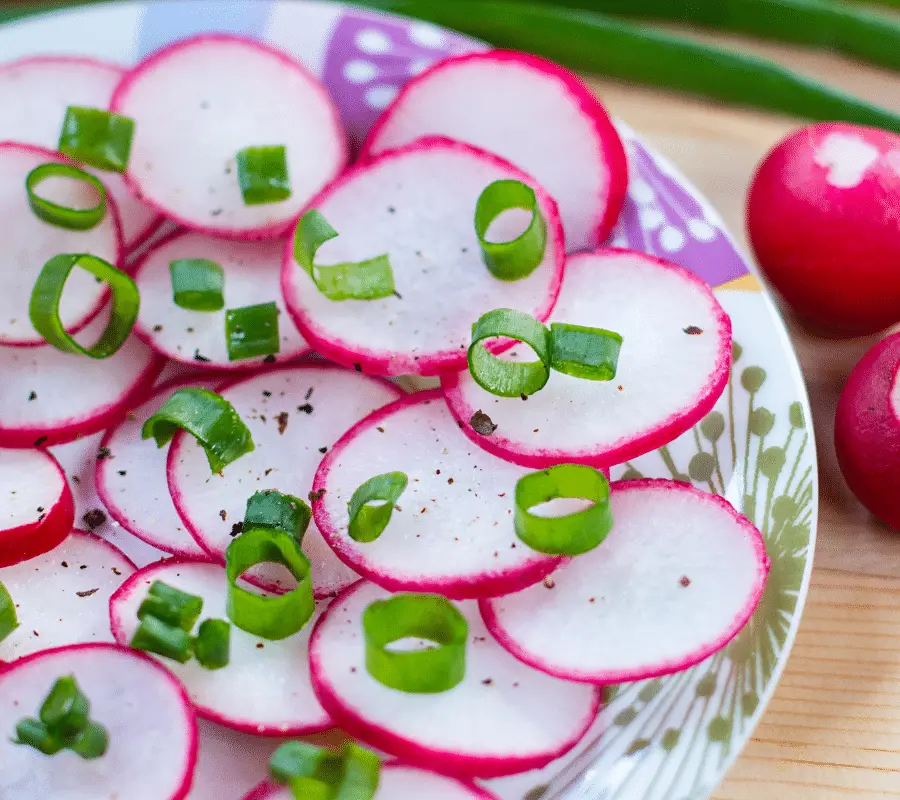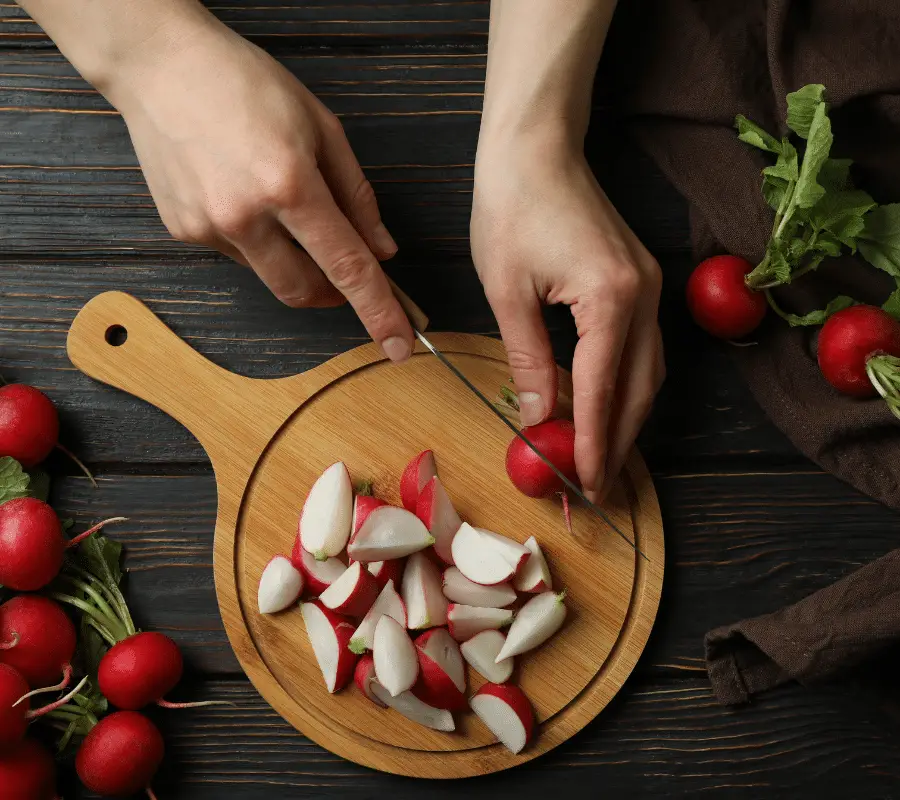How to Cut Radishes: A Beginner’s Guide
Radishes are a popular root vegetable that can add a refreshing crunch to salads, sandwiches, and other dishes. However, cutting radishes can be a bit tricky if you don’t know the proper technique. Fortunately, there are several ways to cut radishes that are easy to learn and will help you get the most out of this versatile vegetable.
Before you start cutting radishes, it’s important to wash them thoroughly under cold running water to remove any dirt or debris. Once they’re clean, you can remove the greens and save them for another use, such as adding them to a salad or sautéing them with other vegetables.
Depending on your preference, you can cut radishes into slices, wedges, or even fancy shapes like flowers. The key is to use a sharp knife and cut them evenly so that they cook or look uniform. In the following sections, we’ll explore some of the most popular methods for cutting radishes, so you can choose the one that works best for you.

Preparation
Before cutting radishes, it is important to prepare them properly. This involves washing and sharpening the knife. Below are the steps for preparing radishes:
- Step 1: Wash the radishes thoroughly under cold running water to remove any dirt or debris. Alternatively, you can soak them in a bowl of cold water for a few minutes.
- Step 2: Dry the radishes with a clean towel or paper towel.
- Step 3: Sharpen the knife to ensure clean cuts. A dull knife can cause the radish to bruise and affect its texture.
Once the radishes are properly prepared, you can move on to cutting them.
Tools you’ll need
Cutting vegetables can be a pain, especially if you’re trying to cut them into thin strips or julienne.
Trying to cut vegetables into thin strips or julienne can be frustrating and time-consuming. You might end up with unevenly cut vegetables, or worse – injured fingers!
Mandolin slicers are the answer. Mandolins make cutting easier and faster than ever before. With our top 3 picks for the best vegetable mandolins, you’ll be able to quickly and easily chop your veggies into perfect slices every time.
Cutting Techniques
Radishes are a versatile ingredient that can be used in a variety of dishes. However, before you can use them, you need to know how to cut them properly. Here are some cutting techniques to help you:
Method 1: Slicing Radishes
The most common way to cut radishes is to slice them. Start by washing the radishes and trimming off the ends. Then, use a sharp knife to slice the radishes into thin rounds. If you prefer thicker slices, adjust the thickness of the slices accordingly.
Method 2: Dicing Radishes
If you need diced radishes for a recipe, start by washing and trimming the radishes. Then, cut them into thin rounds, stack the rounds on top of each other, and slice them into thin strips. Finally, chop the strips into small pieces.
Method 3: Julienne Radishes
Julienning radishes are a great way to add texture to dishes. Start by washing and trimming the radishes. Then, cut them into thin rounds and stack the rounds on top of each other. Slice the rounds into thin strips and then cut the strips into matchstick-sized pieces. Using a mandolin makes life so much easier!
Method 4: Halving Radishes
If you need halved radishes, start by washing and trimming the radishes. Then, cut them in half lengthwise from the root end to the stem end. This technique is perfect for roasting or pickling radishes.
Method 5: Quartering Radishes
If you need quartered radishes, start by washing and trimming the radishes. Then, cut them in half lengthwise and then cut each half in half again. This technique is perfect for adding to salads or serving as a garnish.
By using these cutting techniques, you can easily prepare radishes for any recipe. Remember to always use a sharp knife and take your time to ensure your cuts are even and consistent.

Tips and Tricks
When it comes to cutting radishes, there are a few tips and tricks that can make the process easier and more efficient. Here are some useful techniques:
- Use a sharp knife or a mandoline for clean, even cuts.
- Chill radishes in ice water for 15-20 minutes before cutting to make them easier to handle.
- Experiment with different shapes and sizes to add variety and texture to your dishes.
- Use a vegetable peeler or a microplane grater for more delicate cuts.
- For a decorative touch, try making radial cuts around the top of the radish before slicing it into rounds.
Another useful tip is to use radish greens in your cooking. These leafy tops are edible and can add a peppery flavour to salads, soups, and stir-fries. To prepare them, simply wash and chop them like you would any other leafy green.
Finally, if you’re looking for a way to preserve your radishes for later use, try pickling them. This can be a great way to add a tangy, zesty flavour to your dishes. To make a simple pickle, combine equal parts vinegar and water with some salt and sugar, and add sliced radishes. Let them sit in the refrigerator for a few hours or overnight, and they’ll be ready to use in salads, sandwiches, or as a garnish.
Conclusion
Radishes are versatile vegetables that can be enjoyed in many ways. From adding them to salads to using them as garnish, there are many ways to incorporate radishes into your meals.
When it comes to cutting radishes, there are a few key things to keep in mind. Slicing radishes is the simplest way to cut them. To do this, slice off the top and bottom of the radish and then cut it into thin rounds using a sharp knife. If you want to get more creative, you can use a radish curler to create a coiled or spiral effect.
It’s important to note that radishes can discolour after cutting, but by taking proper care and precautions, it can be kept to a minimum. If you need to slice radishes ahead of time, store them in an airtight container in the refrigerator for up to 3 days. If you have leftover radishes, they can be stored in the refrigerator for up to 6 days.
Overall, cutting radishes is a simple process that can add a lot of flavour and visual interest to your meals. With a little practice, you’ll be able to cut them quickly and easily and enjoy their crisp, refreshing flavour in a variety of dishes.



